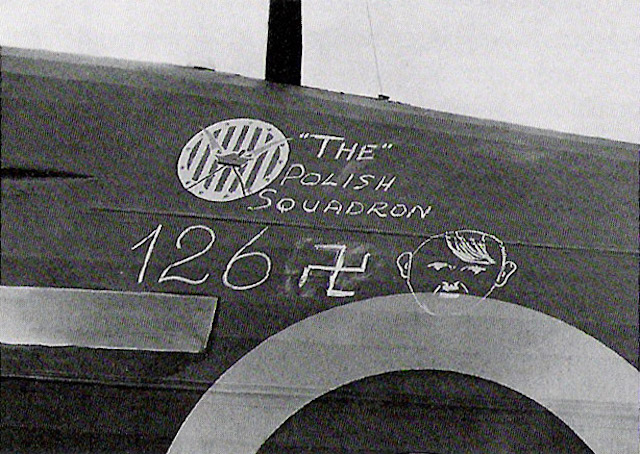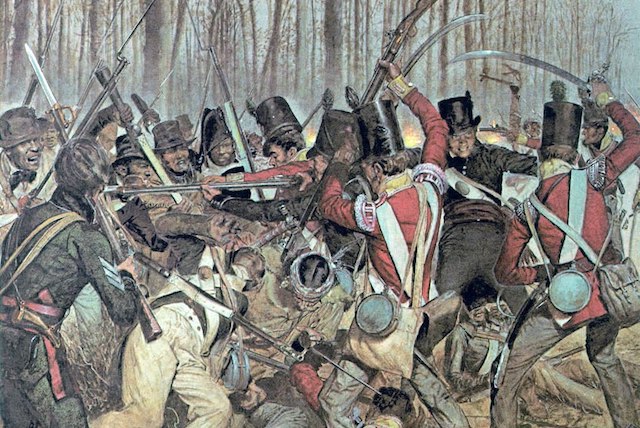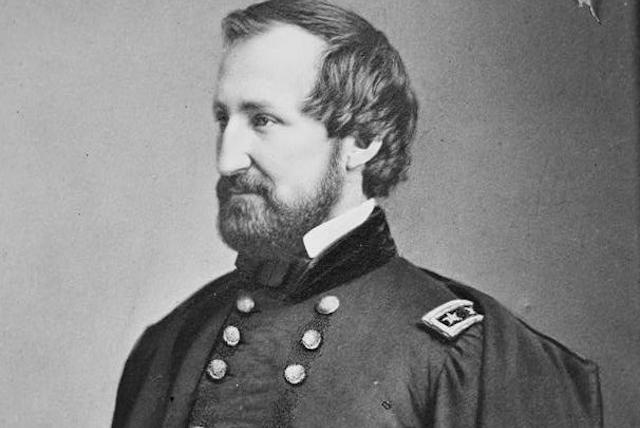In 1913, a French agricultural engineer Max Ringelmann studied people playing tug-of-war. His research led to the observation of the Ringelmann effect. It states that the more people or groups involved in an action, the less effort any individual unit will put forth. Ultimately, there is less blame to be placed on any particular unit in the event of failure, and less confidence in success. Not to mention more infighting, confusion, bottlenecks, bottlenecks, and so on. As we shall see, the Ringelmann effect may certainly be a valid principle.
For the purposes of this list, the largest unit is the "brigade." In the military, a brigade is a collection of regiments (usually about four). A regiment is a group of battalions (often two), and a battalion is a group of companies, with companies usually having about 100 troops. As we will also see, sometimes a company is a much larger group of soldiers than is needed to change the course of a battle, and with it, history.
10. 303rd Squadron

Despite the fact that the Polish nation surrendered in less than a month After the German invasion on September 1, 1939, this was by no means the end of Poland's participation in World War II. In August 1940, 303rd Squadron was formed from refugee pilots from the 1st RAF Police Regiment, assembled in Blackpool, England. Trained on obsolete aircraft back in Poland, they took to their Hawker Hurricanes with such abandon that they rose to the top of the RAF's ranks in the Battle of Britain and remained there for virtually the entire war, shooting down three times the number of enemy aircraft of the average RAF squadron, while suffering one-third losses. Only September 7, 1940 They shot down 14 Luftwaffe aircraft without losing a single person.
Many pundits, both then and in recent years, have credited 303 Squadron with being key to victory. Air Chief Marshal Hugh Dowding said that without their contribution to the Battle of Britain, “I hesitate to say the outcome would have been the same.” Karl Kraff of the New England Air Museum said of the 303, "... They were able to turn the tide of history." Despite their amazing results, their contribution was downplayed for decades, largely due to Poland's presence behind the Iron Curtain, which increased tensions with the British government over its failure to keep its promise to return the Poles to their liberated homeland.
9. Princess Patricia's Canadian Light Infantry

At least by Western standards, it is not ideal for a group of soldiers to have the word “princess” in their regiment name, and this was especially true in the 1950s. The teasing probably stopped after the events of April 24-25, 1951. That was when the 2nd Battalion, Princess Patricia’s Canadian Light Infantry, was deployed to Hill 677 to protect the South Korean army’s retreat across the Kapyeong . valley, about 10 miles from the 38th parallel, in response to a massive Chinese offensive.
To show what with collided 700 Canadians On 23 April, the 3rd Battalion, Royal Australian Regiment, encountered the Chinese and was forced to retreat, suffering heavy losses. The following day, 5,000 Chinese troops launched waves of attacks on the Canadians, including under cover of night. Desperate measures were required to hold the line, with one wounded private having to launch three solo counterattacks. At another point, Lieutenant Michael Levy called on Canadian artillery to shell his position to stop the attack. By the end of the battle, the Canadians were completely cut off, saved only by airdropped supplies. Ultimately, their dedication and bravery would buy the United Nations forces time to regroup and stop the major Chinese offensive.
8. 1st Tank Brigade

Let's talk about the most recent events on this list. It's time to turn our attention to Chernihiv, a city in Ukraine about 60 miles north of Kyiv. When the Russian invasion of Ukraine began on February 24, 2023, this brigade of about 150 tanks and 1200 troops was the only force that stood between the city of 230,000 people and the Russian 41st Combined Arms Group, which included more than 10 battalions. Already February 25 The 1st Brigade stopped the 41st.
By March 6, the heavily outnumbered brigade was expected to surrender as its supply lines were threatened with encirclement. Instead, it not only held out, but suffered far fewer casualties than expected, and managed to shoot down a Russian aircraft. March 23 Having lost 10,000 men, the 41st Division retreated to change strategy, which brought the Ukrainians an unexpected victory.
7. Cavalry reserve in Poitiers

Now that the relatively current events are over, the next entry will take us to the other end of the timeline and take us into the Middle Ages. As far as major battles of the Hundred Years' War (1340-1457) go, the Battle of Poitiers in 1356 A.D. is often overshadowed by the Battle of Crécy a decade earlier and the Battle of Agincourt half a century later. After the end of the 10-year truce following the momentous victory at Crecy, a 12,000-strong English force under the command of Prince Edward The "Blacks" raided central France. They were caught by a 40,000-strong French army under King John II, and despite an attempted retreat by Prince Edward, battle broke out on September 19.
Although the archers had once again had a devastating effect on the French – just as they had done at Crecy – this time the battle was by no means so one-sided. Attacking in three main waves, they threatened to break the English army. Edward sent a force of 160 cavalry around the French army, which sowed panic among the French because they were surrounded. This surprise attack resulted in such a rout that King John II was taken prisoner and his ransom was not paid until 1360.
6. Tzvika Force
In 1973, Syria invaded Israel near the Golan Heights. One of those determined to stop them was 21-year-old Zvika Gringold. He ended up hitchhiking on Nafeh base and was sent to pick up the wounded from two damaged Centurion tanks. Instead, Goldman and company repaired the tanks and intercepted a Syrian column of Russian T-55s. After knocking out six enemy tanks, Zvika Force switched to another tank to continue the fight, deceiving the masses of Syrian tanks and their own Israeli superiors and convincing them that there simply must be more than one tank capable of fighting dozens of enemies.
Eventually, Zvika Force joined a group of a dozen other tanks. Fighting more than 100 additional tanks, Zvika Force was forced to defend Nafeh alone on multiple occasions. Eventually, it was 30 hours before Zvika and company abandoned their Centurion tank, buying more than enough time to fortify the base and stop the invasion. The story was later heavily criticized for being propaganda. Of course, there was some exaggeration of his exploits. For example, some reports put the number of tanks destroyed by Zvika Force up to 60, which Greengold himself said was nonsense. Still, the heroism of this skeleton crew could not be denied.
5. Bill's Rifle Company

The popular image of the Battle of New Orleans in 1815 is essentially of redcoats marching into a massacre by the Americans, inflicting few casualties in return, and two weeks after the war had ended. But this famously misguided attack was the end result of several battles that began in December 1814, and earlier in the battle, things had gone much more favorably for the British. In the first encounter, the British captured five American warships at Lake Borgne and seized the initiative.
Then, on the night of December 23, 1814, the British infantry clashed with Beale's Rifle Company at Wheeler Plantation. Although the battle ended in a stalemate and casualties were roughly equal, British morale was badly shaken and further attacks were delayed, allowing ample time for the defense to be strengthened when the British launched their famous and doomed attack on January 8 of the following year. Unusually for a group that had distinguished itself so much in the brutal fighting, Beale's Rifle Company consisted of traders and lawyers . In twenty years After the battle, the participants were given land plots.
4. Rosecrans at Rich Mountain

On July 11, 1861, at the start of the American Civil War, the Northern Army under General George McClellan confronted the Southern Army under General Robert Garnett at Rich Mountain, Virginia. The Southerners were defending two mountain passes in the Appalachian Mountains and the Staunton-Parkersburg Turnpike, which would be vital if the Confederacy wanted to end the secession of northwest Virginia counties. McClellan sent a brigade of troops under General William Rosecrans to flank the Confederates. Rosecrans did so, then launched an attack as ordered.
As veteran John Beattie reported in his 1879 memoirs, "Citizen-Soldier" , McClellan and his troops could easily hear the fighting going on behind enemy lines, and the troops waited for McClellan to order an attack. But McClellan decided against such an attack because he believed that Rosencrans was beyond rescue. In fact, Rosencrans' brigade routed southerners and captured half of their army.
3. 8th Hussar Cavalry Regiment
On January 22, 1795, Holland was at war with France as the French Revolutionary Wars raged. A flotilla of fourteen Dutch ships froze in the waters off the island of Hexel, about 50 miles north of Amsterdam. Well armed The ships were prepared to be attacked by ships from unfrozen waters or by artillery fire.
So General Jean-Charles Picergu turned to a more unusual weapon to combat the gunboats and ordered a cavalry attack on the ships. The 8th Hussar Cavalry Regiment took the ships so by surprise that they surrendered. faster , than the French dared to hope for in one of the most extraordinary events in military history.
2. Reconnaissance and reconnaissance platoon
When the Wehrmacht launched its final blitzkrieg on December 18, 1944, to begin the Battle of the Bulge, the I&R Platoon of the 394th Infantry Regiment near Lanzerath, Belgium, consisted of just 18 men, led by 20-year-old Lieutenant Lyle Bouck. . . After detecting the approach of the 1st SS Panzer Division, the platoon's communications with high command were cut off by a two-hour artillery barrage, and a group of over 250 organized paratroopers attacked. Unfortunately for the attackers, the platoon had already received orders to hold out at all costs.
Over the next day the platoon inflicted 200 casualties on the enemy and delayed the advance for most of the day until 50 paratroopers mounted a flanking attack at dusk. Amazingly, they suffered only one wound, when Buck was shot in the leg, and one man was killed. The Battle of Lanzerath had provided such an invaluable delay that virtually the entire northern German attack was thrown off schedule for 18 hours , which allowed them to prepare for defense and organize counterattacks much better. It was only in 1981 that the remarkable stand was recognized, and the platoon became the most decorated in the US armed forces.
1. The Lost Battalion
In terms of fighting between Americans and Germans, which largely came down to the actions of one small group, on October 2, 1918, 700 soldiers of the 1st Battalion, 308th Infantry Regiment, under the command of Major Charles Whittlesley, attacked the Germans along the ravine. Charlevoix into the Argonne Forest. With units on either flank stymied, the nine companies reached their objective (according to some accounts, by a breakthrough, according to others, because the Germans lured them into retreat) and were then cut off by the 2nd Landwehr Division. For the next five days, the battalion was subjected to almost relentless sniping, machine-gunning, and attack.
Not only did these isolated troops face countless attacks from vastly superior forces alone, the only point where they received support from the rest of the Allied army actually helped the German army. On October 4, the 152nd Field Artillery Brigade began bombarding the area in an attempt to relieve the battalion, but due to false information, their shells overwhelmingly hit their comrades, killing 30 Human .
The Germans were well aware of this, and when the Americans sent pigeons back to command to call for an end to the bombardment, German snipers picked them off. The only pigeon that got through arrived wounded by a German bullet. The end of the bombardment meant a resumption of German attacks, but even with no food or ammunition, they were able to repel the attacks, and the attempt to destroy the battalion tied down the German forces enough for the rest of the American offensive to break through. Only fewer than 200 men emerged from the battle in good health, having done much to end World War I a month later.
Dustin Koski wrote "Return of the Living" , a post-apocalyptic supernatural comedy.













Оставить Комментарий